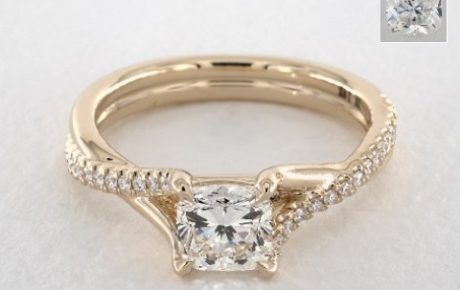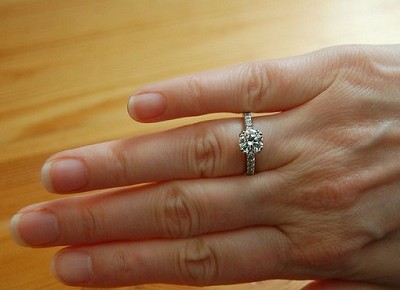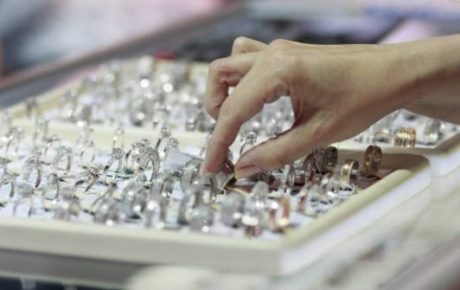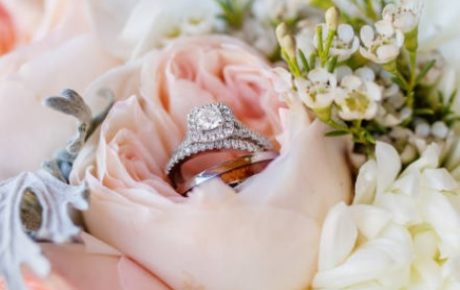A 5 Minute Diamond Knowledge Test – Can You Ace It?

Test your diamond knowledge!
So, you’ve been reading Beyond4cs.com and diligently doing your research on buying a diamond engagement ring. Having read countless articles and referencing real-life diamond examples, you might find your attention span wavering and start to miss out on minute details.
Well, there’s nothing wrong with that as long as you have the gist of the content in your head. Before you enter the jewelry store or hit the buy button at your favorite online store, here’s a short quiz to test your diamond knowledge and how much you know.
The correct answer (with explanations) is found at the bottom of each question (simply click on the questions to reveal the answers). The topics are mixed up in random order to make sure you can dig up information at the back of your mind. Remember, don’t cheat!
What Are The “Four C’s” of Diamonds?
Out of these four, clarity and color describe the diamond’s material properties. Cut describes the quality of work that a diamond cutter had put into polishing the stone and carat represents the metric weight of the diamond (a carat equals two hundred milligrams).
Which Diamond Shapes Had You Heard Of And Which Is The Most Popular?
What Are The Different Clarity Grades That Describe a Diamond?
The two highest clarity grades for diamonds are FL (flawless) and IF (internally flawless). Because of their rarity, diamonds with these grades don’t come cheap. The much more consumer friendly categories are VVS1, VVS2 (very very slightly included) and VS1, VS2 (very slightly included).
If you are on a tight budget, you might want to consider buying a diamond graded at SI1 or SI2 (slightly included) clarity. Make sure you view images or videos of the diamond before committing to a purchase. My word of advice is to avoid buying I1, I2, I3 (included) diamonds unless you totally know what you are doing.
Included diamonds are a minefield for consumers looking for good deals as they aren’t usually “eye clean” and have durability issues. I’m sure you don’t want to see visible inclusions while enjoying the look of your diamond jewelry and neither would you want the additional risks of damaging your diamond because of low clarity grades.
What is a Blood Diamond?
A blood diamond – or “war diamond”, “converted diamond”, “hot diamond” – is one that has been mined under controversial circumstances in a war zone. These diamonds are sold in order to finance the ongoing insurgency or to finance the needs of the warlord.
Blood diamonds originate from countries in Africa (mainly Angola, Ivory Coast or Liberia) and the commercialization of such diamonds had been banned in the United States and European Union. Due to trade laws and strict regulations, these diamonds don’t have the proper paperwork to trace their origins and are often transacted in illegal smuggling and underhand dealings.
You can avoid buying blood diamonds by asking for a written guarantee and proof that the rough diamond was mined in accordance with the Kimberly Process.
For more readings on this topic, visit AmnestyUSA.org and Global Witness.
Are Online Jewelry Stores Trustworthy?
There is nothing wrong with having a natural level of skepticism when purchasing items that cost thousands of dollars online. In today’s modern world, I’m sure most of us have had some experience with electronic commerce at some point in time. You do see actual books being delivered after making a purchase at an online bookstore. Even fragile and expensive items like a laptop can be bought online with no apparent issues.
Diamond businesses are no different. Sure, there are bad eggs which tarnish the name of the industry but there are also plenty of great places to buy high quality diamond rings too!
Did you know that many renowned online diamond vendors have come a long way since the Internet hit the world? Some of them have been around for almost two decades and have been used by millions of people since. The simple fact that they are still in business and have tons of positive consumer reviews are a testament that they are trustworthy entities and not some fly-by-night business.
How Can You Calculate With Carats?
FYI: The term carat is historically used by traders in ancient times before metric units like grams or milligrams were introduced. Till date, the industry has kept the tradition of using “carats” to describe a diamond’s weight.
What is the Difference Between Carat Weight And Carat Total Weight?
Carat weight represents the weight of a single gemstone denoted in carats. On the other hand, carat total weight represents the weight summation of ALL gemstones found in a piece of jewelry. The important thing to know when purchasing rings or settings with CTW descriptions is that prices do not necessarily increase with their weight linearly.
When multiple diamonds (of possibly different qualities) are featured in a piece of jewelry, the value placed on the carat total weight might be misleading and misrepresented by unethical jewelers.
Here’s a reality check: a 2.00 CTW proposal ring might sound impressive but it would likely cost less than the price for a 1.00 carat solitaire diamond engagement ring. Always read the details of the ring description carefully!
What Does It Mean If a Diamond Has No Visible Flaws? Is It a Good Deal?
It depends. “Eye clean” diamonds can exist and span across different clarity grades. Just because you cannot see inclusions with your naked eye doesn’t mean that the diamond is “flawless” or the inclusions won’t pose a serious issue. Take note – minute inclusions which can affect the diamond’s brilliance may sometimes not be visible to the unaided eye.
For example, if you are buying an SI2 diamond with a comment “Clarity grade based on clouds not shown” in the grading report, you better think twice. That comment is the unholy stamp of death for a diamond’s brilliance and is a sign for you to be extra cautious. More details can be found here: https://beyond4cs.com/grading/other-comments/.
In most scenarios, diamonds with inclusions in less visible areas or can only be seen under a 10X loupe offer the best value for consumers. As long as the diamond is eye-clean, a VS2 or SI1 diamond can look just as good as an IF diamond. After all, I don’t think people would go around inspecting someone else’s ring with a loupe in real life.
Does Clarity Enhancement Strengthen a Diamond?
No. The most common method used in clarity enhancement is to drill a small hole into the diamond using a laser beam. This laser drilled hole becomes a pathway for chemicals to bleach away foreign material residing within the diamond. The end result of this is a better looking diamond which looks more appealing to the eye after treatment.
Even though the diamond’s perceived clarity is probably going to improve, its mechanical strength will become less from a mechanical viewpoint. By drilling a hole, the integrity of the diamond’s structure is somewhat compromised to a certain extent. With that said, this process is typically not detrimental to the diamond’s mechanical structure when performed correctly.
A Diamond Can be Chipped or Broken Very Easily – True or False?
Depending on the diamond’s cut and shape, some are more susceptible to damage than others. With some common sense and a proper setting, your diamond is probably not going to be damaged even if you wear it on a daily basis.
The most important routine check you can do is to make sure the setting is sound and secure. If anything is, prongs are the biggest enemies of a diamond. Why so? In the event the prongs get bent or broken, the chances of losing your diamond entirely is much higher than the risk of chipping it. For regularly worn jewelry, it is best to have them checked by a professional on an annual basis.
For a more detailed read, check out this section of the website to refresh your knowledge: https://beyond4cs.com/care-and-maintenance/
If you had understood the key concepts about buying diamonds, these are questions you should be able to answer easily. If you can’t, you should probably review the answers and read up a little more at Beyond4Cs.com.
Related Articles
Leave A Comment














12 Comments
Paul has compiled the most comprehensive and extensive diamond and diamond jewelry website that is available — period. Whether you are looking for basic knowledge of diamonds or want to learn advanced topics in diamond grading, this is the best place to start learning!
For a cathedral ring design, would the choice of yellow or white gold be better for someone with darker skin tones?
I think it is up to personal preferences as your recipient’s tastes is what matters most. However, if you asked me, I would say yellow gold tend to look better on darker skin tones compared to lighter tones. I recently did a comprehensive article about the cathedral setting engagement ring and discussed the pros/cons of the style. Do give it a read.
Hi Paul,
I have really really appreciated your site, and it truly feels like one of the most open, clear and honest sources for diamond purchases. Will definitely link through your site when I make my purchase.
I am looking to buy a loose cushion cut diamond (I can’t tell the difference/have a preference between a standard cushion cut and a cushion modified as they both present themselves with various sparkle/scintillation/crushed ice/etc that I cant distinguish!) to be mounted into a Tacori setting (purchasing setting and mounting through “Robbins Brothers,” a semi large chain in Southern California). Setting is this one, if you need to see it: robbinsbrothers.com/0375548-tacori-ladies-18k-white-gold-and-diamond-engagement-ring1073319636
After their rather exorbitant diamond pricing (“Its because we guarantee the center stone for life if it falls out, and we hand select the best cuts!”) I have decided to do my best to educate myself and get a loose stone online but have them mount it, resize, clean regularly, etc. And after reading your site and realizing the downsides of local shops, I feel better about that decision.
After reading significant parts of your site, and trying to filter out the “best” proportions/GIA ratings/viewing only HD video stone options, I have come up with these stones below. I have not yet asked James Allen to provide the ASET images for any stones as it sounded like 3 stones is the max (and I assume Blue Nile cannot provide any ASET on reading your site? Has this changed?), but based on your feedback I would plan to ask for ASET info on the “3 best” James Allen options after hearing from you. Whiteflash and Brian Gavin had very limited options once all the below filters were set, or were $8k plus
Main guidelines:
– Carat: 0.97 ct to 1.25 ct max (setting likely cant safely fit a stone larger than 1.25), would prefer the 1.1-1.2 range but flexible.
– Color: H+
– Clarity: Prefer VS1+ since I am buying online and more skeptical (and this aligned with some of your comments) but would be happy with a “trustworthy” eye clean SI1+, most look very scary in the HD videos.
– Cut: choosing the highest cut on each website for cushion (VG on bluenile, ideal on James Allen, although sounds like this is semi worthless for fancy shapes?) but then trying to align proportions to your suggestions: (Table 58-63, Depth 58-67, Girdle Thin-Slightly Thick, Polish excellent, Symmetry VG+). Not sure what the differences are between an elongated cushion cut vs a square cushion cut.
– Cost: Would like to stay under (or close to) $6k for the diamond alone.
Hopefully this isn’t too much information, and here are the stones I am looking at, would really love your opinion if any jump out or which I should ask for “further analysis” of for the James Allen’s, or if the Blue Nile options are sufficient with the given information (Blue Nile seems to have more video than years past when you describe them having very little evidence of their stones?).
In order of my interpretation as “best” options (not listing color, carat, or clarity for James Allen as its in link title), would likely lean towards 1st stone option if the ASET comes back positive or 2nd stone as a “cheaper” and smaller option if also a solid cut, but it feels too cheap that it makes me nervous? If you don’t have time to look at all options, please focus from the top down.
1. https://www.jamesallen.com/loose-diamonds/cushion-cut/1.23-carat-h-color-vvs1-clarity-sku-3689498 – 66.8% depth, 63% table. Excellent/Excellent. Med-SlightlyThick. Med-blue fluorescence something to be worried about? Only other concern is the size and cost is at the high end. $5730
2. https://www.bluenile.com/diamond-details/LD00029206 – 1.07 ct, H, VVS2. 63.5% depth, 60.0% table. Excellent/Excellent. Slightly thick (why only 1 dimension?). 1.06 L/W ratio. Best “cheap end” option, and don’t see any inclusions. Is girdle an issue? Too good to be true?? $3512
3. https://www.bluenile.com/diamond-details/LD09794233 – 1.22ct, H, VVS1. 66.8% depth, 61.0% table. Excellent/Very Good. Med-Thick. No fluorescence, but otherwise very similar to 1st stone but with lower symmetry (and no James Allen ASET). $5366
4. https://www.jamesallen.com/loose-diamonds/cushion-cut/1.07-carat-h-color-vs2-clarity-sku-3537054 – 61.3% depth, 61% table. Excellent/Very Good. Thin-Slightly Thick. Proportions are “excellent” but looks odd? Too shallow? Video looks off, maybe poor symmetry. $3930.
5. https://www.jamesallen.com/loose-diamonds/cushion-cut/1.20-carat-h-color-vs1-clarity-sku-4561044 – 65.1% depth, 60% table. Excellent/Excellent. Med-SlightlyThick. Cert shows an inclusion dead center, but I cant see anything on the video, assume VS1 is safe here? $5540
6. https://www.jamesallen.com/loose-diamonds/cushion-cut/1.06-carat-h-color-vs1-clarity-sku-3711387 – 66.7% depth. 62% table. Excellent/Very Good. SlightlyThick-Thick. 1.06 L/W ratio. I am OK with carat being low as price is low too, but should symmetry and girdle specs be a concern? $3580
7. https://www.jamesallen.com/loose-diamonds/cushion-cut/1.04-carat-f-color-vs1-clarity-sku-4328684 – 66.2% depth, 62% table. Excellent/Very Good. Med-Thick. 1.12 L/W. Nice on all fronts, although a number of small inclusions in center visible in HD video. Not a concern? $4690.
Apologies again for the long email! Would love to get feedback tomorrow if possible, as I am ready to jump on one of these this week.
For your case, James Allen and Blue Nile are the best places to shop for cushions. White Flash and Brian Gavin specialize in rounds and princesses. BGD does offer a hearts and arrows cushion cut diamond range but they are fairly limited in inventory size.
This article here will help you address eyecleanliness issues: https://beyond4cs.com/clarity/resize-technique/
Now, when it comes to cushion cut diamonds, the proportions table is just a guideline. What is most important is the video listing which reveals performance.
I can tell you outright that this diamond has the best performance and brightness out of all the diamonds you shortlisted:
https://www.jamesallen.com/loose-diamonds/cushion-cut/1.23-carat-h-color-vvs1-clarity-sku-3689498
Ditch all the other stones. They aren’t as well cut. However, given that this is a VVS1, it does have a premium on clarity. So, I took the liberty to do a search for you and would recommend these diamonds instead if you want better value for money:
https://www.jamesallen.com/loose-diamonds/cushion-cut/1.20-carat-h-color-vs2-clarity-sku-3355407
https://www.jamesallen.com/loose-diamonds/cushion-cut/1.25-carat-h-color-vs1-clarity-sku-3636638
Both of these stones are eyeclean and cut for light performance. I do have preferences for the VS2 diamond as it gets you better value for money.
Many thanks for the quick response.
I generally understand your guidance below, including that the proportions are just a guideline, however I was quite surprised that the 1.20 carat you recommended as a “better cut” was a pretty extreme depth of 71.4% (Fair/Poor “outside range” per your https://beyond4cs.com/shapes/cushion/ guidance).
What exactly is it that demonstrated to you that the three diamonds you recommended had the ‘best cut’ if not the proportions or the ASET/Idealscope/etc? The video listing demonstrating the “better” brightness/scintillation/shimmer/etc that your eyes were just able to recognize? Something you learn from the additional cut angles that seem to be included for your stones but aren’t on mine (i.e. crown and pavilion angle/percentage?) I had thought I was following your general guidance from beyond4c’s blogs (although still waiting on the ASET checks on my “final” stones) but now I am a bit thrown where my focus should be.
At this point, I lean towards the VVS1 $5700 option (https://www.jamesallen.com/loose-diamonds/cushion-cut/1.23-carat-h-color-vvs1-clarity-sku-3689498) as the price is about the same as the 1.25 VS1 (https://www.jamesallen.com/loose-diamonds/cushion-cut/1.25-carat-h-color-vs1-clarity-sku-3636638) that you recommended, unless you are suggesting that that VS1 is a “better brilliance” stone, which I would love to hear how you can tell! I will request the ASET options for all 3 stones tomorrow.
Would you have any other stone recommendations in a slightly smaller carat/price, closer to the 1.1 ct range?
Thanks again, and apologies if this is too many questions!
The basis for the recommendation is performance and to get good value for money without overpaying for features and specs that the eyes can’t see.
This would be a 3rd diamond I would recommend: https://www.jamesallen.com/loose-diamonds/cushion-cut/1.10-carat-g-color-vvs1-clarity-sku-3736334
Get an ASET scope for the diamonds and send it to me via email if you want me to review them for you. These 3 will have very strong light return.
Great, thanks again. I am requesting the ASET on these them today.
Thanks for the alternative recommendation for a smaller and cheaper stone (same characteristics as before), in the 1.1ct range for <$5k range. I wanted a backup as I am worried that the 1.25 ct might be too big for the setting.
Thank you again!
Two quick follow ups, if you don’t mind.
I did confirm that 1.25 ct size works in my setting, so I am trying to choose a “3rd” stone option in that range for James Allen to send ASET images. James Allen customer services have been down due to a winter storm so have not been able to get the images for the last 2 days, but they are back today, so I am going to follow up with my 3 specific stones.
The two I am already requesting, based on your suggestions:
https://www.jamesallen.com/loose-diamonds/cushion-cut/1.23-carat-h-color-vvs1-clarity-sku-3689498
https://www.jamesallen.com/loose-diamonds/cushion-cut/1.25-carat-h-color-vs1-clarity-sku-3636638
I would like to include one more ~1.25ct option stone, these below are all cushion modified brilliant – Hybrids (“x-factor” I believe?) which are in line with the previous recommendations, but slightly lower clarity on all and a few inclusions right in the center on the top two, but look eyeclean using the resize technique you mentioned. Which would you suggest I request for my 3rd stone ASET images, unless there are others I might have missed?
https://www.jamesallen.com/loose-diamonds/cushion-cut/1.20-carat-h-color-vs1-clarity-sku-4597536 – $5470
https://www.jamesallen.com/loose-diamonds/cushion-cut/1.20-carat-h-color-vs2-clarity-sku-4416302 – $5290
https://www.jamesallen.com/loose-diamonds/cushion-cut/1.25-carat-f-color-vs1-clarity-sku-4508801 – $6460
Final question, what is your recommendation on the Brian Gavin Signature H&A Cushion? With the above stones in the mid 5’s to low 6’s, the 7.5k for a Brian Gavin signature is not too different. Is a $2k jump to get to the signature H&A cuts seem reasonable? Is the different cut style the main significance, or more the quality of the cut that differentiates them? Any advice here appreciated.
The stone I was looking at below: https://www.briangavindiamonds.com/diamonds/diamond-details/1.215-h-si1-cushion-diamond-ags-104095878008
I would include this: https://www.jamesallen.com/loose-diamonds/cushion-cut/1.25-carat-f-color-vs1-clarity-sku-4508801
The other 2 are not well cut with too much contrast. The Brian Gavin diamond is definitely well cut for light performance. I have seen a number of them in person and they are consistently great.
They actually have performances like round diamonds. Price wise, they are slightly steep but if performance and the way it looks matter to you, then this would be a good choice.
In the world of cushion cut diamonds, I will say that the 2 previous stones + the one on top from JA, are very well cut. They just take on a different flavor from the BGD option.
I hope this makes sense.
Either way, the 4 diamonds are good choices and winners in their own rights.
I’ve sent you an email with ASET images provided from James Allen for the 3 stones below (Let me know if any issues with the attachment?). Can you please take a look at these three and give me your feedback on their qualities?
The stones I ended up requesting were all from the emails and lists you have discussed with me below, although at the last minute when I was requesting one of the 1.25 ct stones (SKU 3636638) it ended up being unavailable, so I included the 1.10 ct (stone 3 below) that you had recommended earlier this week in case I want to default to a smaller stone.
From my interpretations of the ASET’s, Stone 1 (SKU 4508801) looks to have the best light symmetry, but also the most blacks and the least red. As the most expensive stone as well, I do not lean towards this option based on the seemingly poor ASET compared to the others.
Stone 2 (SKU 3689498) looks to have the strongest red light feedback and relatively limited white/black, although a pretty significant white dead center (is that an issue?) and poor light symmetry overall, especially of the blues.
Stone 3 (SKU 3736334) I interpreted to have the best ASET overall, with good amount of red including out to the edges, the most limited white/black, and decent light symmetry.
I currently lean towards either Stone 2 (1.23 ct) or stone 3 (1.1 ct) being both good stones that I would be happy with, and then just deciding which size I want, but would love your assessment and to let me know if I am interpreting this correctly.
Thank you again for all of your help in this process!
All 3 are well cut for light performance in the world of cushion cuts. First of all, ASETs like these are not normal. Most of cushion cuts have junk quality and light return.
Really, you can’t go wrong with any of the diamonds.
At this point in time, budget and personal preferences play a role here.
I do have preferences for a slightly elongated look and would recommend the SKU 3736334 diamond but I hope this doesn’t instill any bias to your choice. At the end of the day, all 3 stones are fantastic.